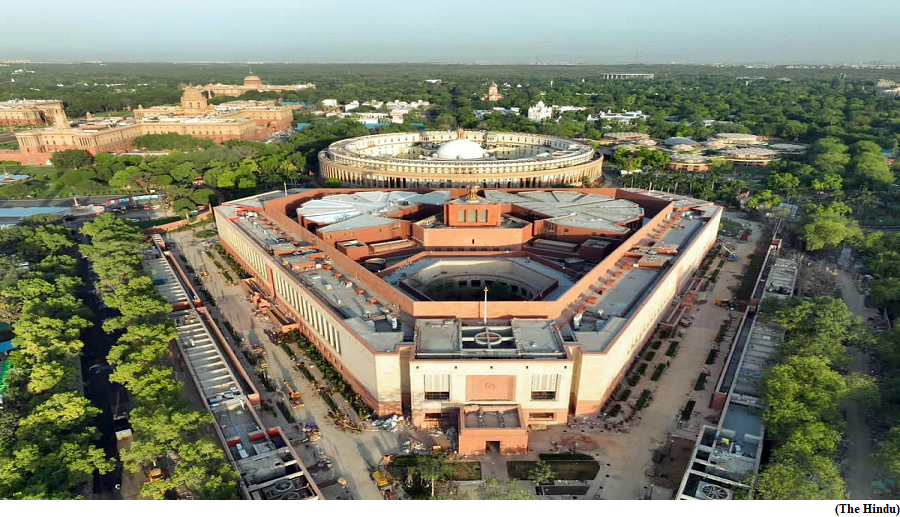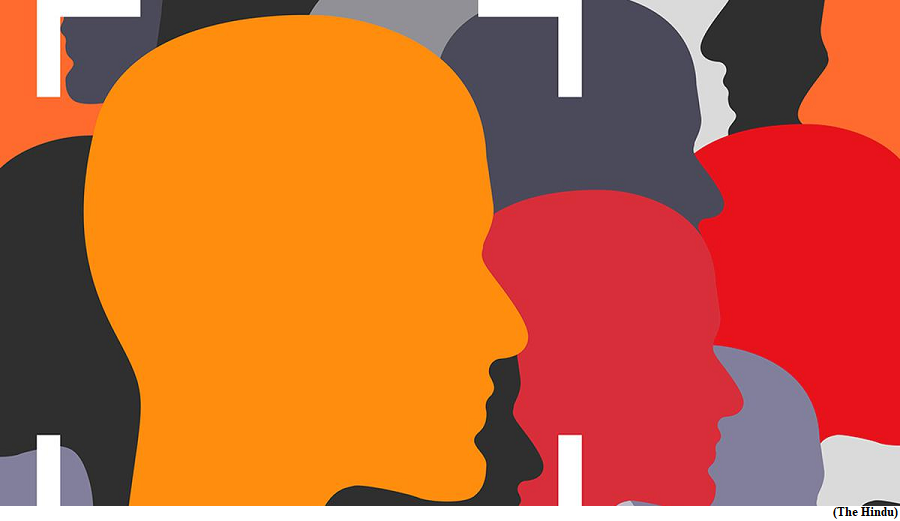A new House, again in red sandstone (GS Paper 2, Governance)

Why in news?
- Recently, the Prime Minister inaugurated the new Parliament building and installed the "Sengol" near the seat of the Lok Sabha speaker.
- The new Parliament building, which has been constructed as a part of the Central Vista Project, will replace the old building which was constructed nearly 100 years ago, in 1927.
- The foundation stone of the new building was laid by PM Modi on December 10, 2020.
Key Highlights:
- The new triangular Parliament House, built to fit the three-sided plot of land on which it stands, faces the old circular structure, both dressed in red sandstone for continuity. Their interiors though, are a study in contrast.
- Noida-based sculptor Ram Sutar’s 16-foot-high bronze Mahatma Gandhi sits in between, the silent arbitrator between the past and the present.
- In place of the “disappearing dome” over the central hall, visible to visitors only once they step in, the new building is flat-roofed and fitted with a golden spire, much like those in temples and gurdwaras.
- Where the old building, opened in 1927, had wooden panelling and high ceilings, the new four-storey structure has lights embedded into ceilings of gold. Peacock feather motifs are emblazoned on both the ceiling and carpet in the Lok Sabha, and lotus motifs in the Rajya Sabha.
- The tradition of red upholstery, carpeting and wall cladding for the Upper House and green for the Lower continues.
- Now, there is no central hall that was used for joint parliamentary sessions a few times a year, a space that also turned into a lounge for members to gather and dissolve party differences. In its place is an open-to-the-sky courtyard and three cafes as a neutral ground.
Sitting capacity:
- With the old, it was the fact that British architect Herbert Baker imagined it as a triangular building with chambers of varying shapes within.
- The new Lok Sabha can seat 888 members, with the capacity to expand it to 1,272 during joint sessions of Parliament, while the Rajya Sabha will seat 384. Both chambers are roughly three times bigger than those in the old Parliament.
- The old Lower House chamber had a significantly inadequate 148-member capacity at inception, necessitating remodelling for expansion in the 1950s, with the first floor added in the 1960s.
- The increased floor space came at the cost of aesthetics and convenience, with many seats placed behind the 12 pillars that hold up the building.
- Similarly, the Upper House could initially accommodate only 86 members, and alterations were made to increase its capacity to 250.
- There are now 92 chambers for Cabinet Ministers and party offices. Traditionally, the real estate was allotted as a measure of hierarchy, with the more powerful portfolios getting larger rooms and with a suite for the Prime Minister.
Contribution of states:
- Cushioned seats with desks are provided for members, with two people to a seating unit. Each seat has a biometric-based digital voting console and a smart screen for members to access documents.
- Interiors have been made “disruption proof”, with the Chairperson and Speaker’s seat placed at a higher elevation than in the old building, making it difficult for Opposition members to wave placards in their faces.
- The reporters’ table, where key officials in charge of running the administration of Parliament sit, now has a wooden barricade running all around it.
- Nearly every State has contributed something to the new Parliament. The teakwood came from Maharashtra, the sandstone from Rajasthan, the carpets from Mirzapur in Uttar Pradesh, and bamboo flooring from Tripura.
Iron fortification, health risks of excessive iron intake
(GS Paper 2, Health)
Context:
- Iron is an essential mineral required for many bodily functions, including the formation of haemoglobin, but can be harmful when taken in excess.

Fortification:
- One of the methods suggested for the treatment of iron deficiency anaemia is fortification of food with iron.
- Typically, a chosen food staple such as wheat, rice, or even salt, is fortified to provide up to two-thirds (10 mg/day) of the iron requirement of adult women, and almost the entire daily requirement of men.
- Thus, excess consumption of iron can occur if one habitually consumes a balanced quality diet to begin with or exceeds limits for consumption of the fortified food.
Tolerable upper limit:
Iron absorption:
- Recent studies showed that with fortification, there is an increased excretion of iron in children. It is not known exactly how or through what route this extra excretion takes place.
- It is likely that the extra iron is lost through the intestine, where cells of the intestinal lining exfoliate or drop off, and thereby deposit their iron into the intestine lumen for excretion, or through the urine.
- Nevertheless, beyond the excess stores, the net effect of iron provision through fortification on haemoglobin formation is likely to be lower than thought.
- To the extent that the body can, it will try to regulate iron absorption. But excess iron in the fortified diet can remain unabsorbed.
- Typically, it is expected that just 5-10% of the ingested iron is absorbed. The rest is excreted.
Harmful effects:
Chronic disease risk:
Way Forward:
- Even though iron fortification has been successful in addressing iron deficiency, it is important to consider the dangers of consuming too much iron.
- Rather than adopting mandatory iron fortification programmes where unsupervised high iron intakes are instituted across a diverse population, it is imperative to develop individualised strategies and ensure thorough monitoring to detect any adverse events at the earliest.
Will AI tools help detect telecom fraud?
(GS Paper 3, Science and Technology)
Why in news?
- To weed out rampant cases of fraudulently procured SIM cards being used across the country for financial and other cyber scams, the Department of Telecommunications (DoT) has begun using an artificial intelligence-based facial recognition tool named ‘Artificial Intelligence and Facial Recognition powered Solution for Telecom SIM Subscriber Verification’ or ASTR.
- ASTR has already been used in multiple States such as Haryana, Gujarat, Maharashtra, Tamil Nadu, and Kerala.

Why is AI used to detect telecom frauds?
- Recently, the Punjab police had blocked 1.8 lakh SIM cards allegedly activated using fake identities, out of which 500 connections were obtained using one person’s photo but different accompanying KYC (Know Your Customer) parameters such as names, address proofs, and so on.
- India is the second-largest telecom ecosystem in the world, with about 117 crore subscribers. While manually identifying and comparing the vast number of subscriber verification documents such as photographs and proofs is a massive exercise.
- The DoT aims to use the facial recognition-based “indigenous and NextGen platform” ASTR to analyse the whole subscriber base of all telecom service providers (TSPs).
- Besides, the currently available conventional text-based analysis is limited to finding similarities between the proof of identities and verifying whether such information is accurate but it cannot trawl photographic data to detect similar faces.
What is ASTR?
- Facial recognition is an algorithm-based technology which creates a digital map of the face by identifying and mapping an individual’s facial features, which it then matches against the database to which it has access.
- In 2012, the DoT had directed all TSPs to share their subscriber database including pictures of users with the department. The ASTR analyses this database provided by TSPs and put them into groups of similar-looking images using facial recognition technology (FRT).
- In the next step, it compares the associated textual subscriber details with pictures in the database and uses a string-matching concept called “fuzzy logic” to identify approximately similar-looking names of users or other KYC information to group them.
- The last step is determining if the same face (person) has acquired SIMs in multiple names, dates of birth, bank accounts, address proofs, and other KYC documents.
- Alternatively, ASTR also identifies if more than eight SIM connections have been obtained in one person’s name, which is not allowed as per DoT rules.
What are the concerns associated with the use of facial recognition AI?
- The use of FRT involves issues related to misidentification due to the inaccuracy of the technology. An algorithmic FRT, which is trained on specific datasets may have limits to its knowledge, that is, it might make technical errors due to occlusion (a partial or complete obstruction of the image), bad lighting, facial expression, ageing and so on.
- Errors in FRT also relate to the underrepresentation of certain groups of people in the training datasets. Studies on FRT systems in India indicate a disparity in error rates based on the identification of Indian men and Indian women.
- Extensive research globally has revealed that its accuracy rates fall starkly based on race, gender, skin colour and so on. This, in turn, can result in a false positive, where a person is misidentified as someone else or a false negative, where a person is not verified as themselves.
Privacy Issue:
- Other concerns about FRT, relate to privacy, consent, and mass surveillance. The Supreme Court in the Puttaswamy case had recognised the right to informational autonomy as an important part of the right to privacy enshrined in Article 21.
- FRT systems consume and compute vast amounts of biometric facial data, to both train and operate. In many cases, an individual may not be in control of the processing of their data or not even be aware.
- In the case of ASTR, digital policy-watcher and news organisation Medianama pointed out in its findings that there was no public notification issued about the use of ASTR on user data provided to TSPs at the time of obtaining connections.
- An RTI filed by the publication with the DoT did not reveal any information about how ASTR safeguards data or for how long it retains customer data. This raises questions about privacy and consent even if ASTR is being used on the principle of deemed consent mentioned in the now-withdrawn data protection bill.
What is the legal framework for such tech?
- In several jurisdictions world-over which are using FRT in their governance and privately, players have to adhere to the local personal data protection regimes if AI regulation is not in place.
- In India, there is no data protection law in place after the government withdrew the Personal Data Protection Bill, 2019 last year following extensive changes recommended by a Joint Parliamentary Committee. Secondly, India also does not have an FRT-specific regulation.
- However, NITI Aayog has published papers enunciating India’s national strategy towards harnessing the potential of AI reasonably.
- It says that the use should be with due consent and should be voluntary and at no time should FRT become mandatory. It should be limited to instances where both public interest and constitutional morality can be in sync.




